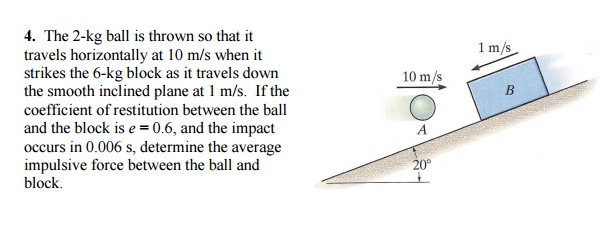
The equation for impulse, Δ p, \Delta p, Δ p, can in fact be derived from this law:į = m a, a = Δ v Δ t ⇒ F = m Δ v Δ t = m Δ v Δ t. Now, aren't there other forces on this ball Isn't there a force of gravity And if there is, doesn't that mean what we really found here wasn't the impulse. This is in fact Newton's second law, F = m a F = ma F = m a. Quantitatively, the effect we are talking about is the change in momentum, Δ p Δ p size 12as previously described, and consider the change in momentum of the first ball that strikes perpendicular to the wall.When a force is applied to an object, no matter what the state of that object's motion is, acceleration will occur.

For example, if the ball were thrown upward, the gravitational force (which is much smaller than the tennis racquet’s force) would eventually reverse the momentum of the ball. You'll need to measure the duration of the collision between the ball and.

Hint: Remember that the exerted force is equal to change in momentum/elapsed time or:ApFAT N 4. A small force could cause the same change in momentum, but it would have to act for a much longer interval of time. Your goal is to use the impulse-momentum theorem to determine the magnitude of the average force the wall imparts on the ball. In Example 8.1, a very large force acting for a short time had a great effect on the momentum of the tennis ball. The mass is equal to the product of the meteor’s density and its volume: m V. From (Figure), J mv J m v, so we have F ave mv t. The effect of a force on an object depends on how long it acts, as well as how great the force is. The average force during the impact is related to the impulse by F ave J t. 4.B.2.2 The student is able to perform analysis on data presented as a force-time graph and predict the change in momentum of a system.4.B.2.1 The student is able to apply mathematical routines to calculate the change in momentum of a system by analyzing the average force exerted over a certain time on the system. Textbook solution for Engineering Mechanics: Dynamics (14th Edition) 14th Edition Russell C.3.D.2.4 The student is able to design a plan for collecting data to investigate the relationship between changes in momentum and the average force exerted on an object over time.Figure 53 shows the typical time history of an impulsive force, f(t). 3.D.2.3 The student is able to analyze data to characterize the change in momentum of an object from the average force exerted on the object and the interval of time during which the force is exerted. Clearly, the momentum of the ball is changed by the collision with the wall.3.D.2.2 The student is able to predict the change in momentum of an object from the average force exerted on the object and the interval of time during which the force is exerted.3.D.2.1 The student is able to justify the selection of routines for the calculation of the relationships between changes in momentum of an object, average force, impulse, and time of interaction.Show transcribed image text Expert Answer 100 (3 ratings) Transcribed image text: The 0.15-kg ball has a speed of v1 23 m/s just before it is struck by the bat. The information presented in this section supports the following AP ® learning objectives and science practices: See Answer Determine the magnitude of the average impulsive force imparted to the ball if it is in contact with the bat for 0.8 ms. Your goal is to use the impulse-momentum theorem to determine the magnitude of the average force the wall imparts on the ball.

The baseball forces the bat in one direction and the bat forces the ball in. What is the reaction force of a bat hitting a baseball The ball exerts an equal and opposite force on the bat. Compute the average force applied by the club on the ball Answer: m (Mass) 0. The golf club is in contact with the ball for 3 s. Calculate average force and impulse given mass, velocity, and time The impulse delivered by this force is the product of the average force the the contact time resulting in an impulse of 12.91 Ns. Example 2: A golfer hits a ball of mass 45g at a speed of 40m/s.Determine the average effective force using graphical representation.Describe effects of impulses in everyday life.By the end of this section, you will be able to do the following:


 0 kommentar(er)
0 kommentar(er)
